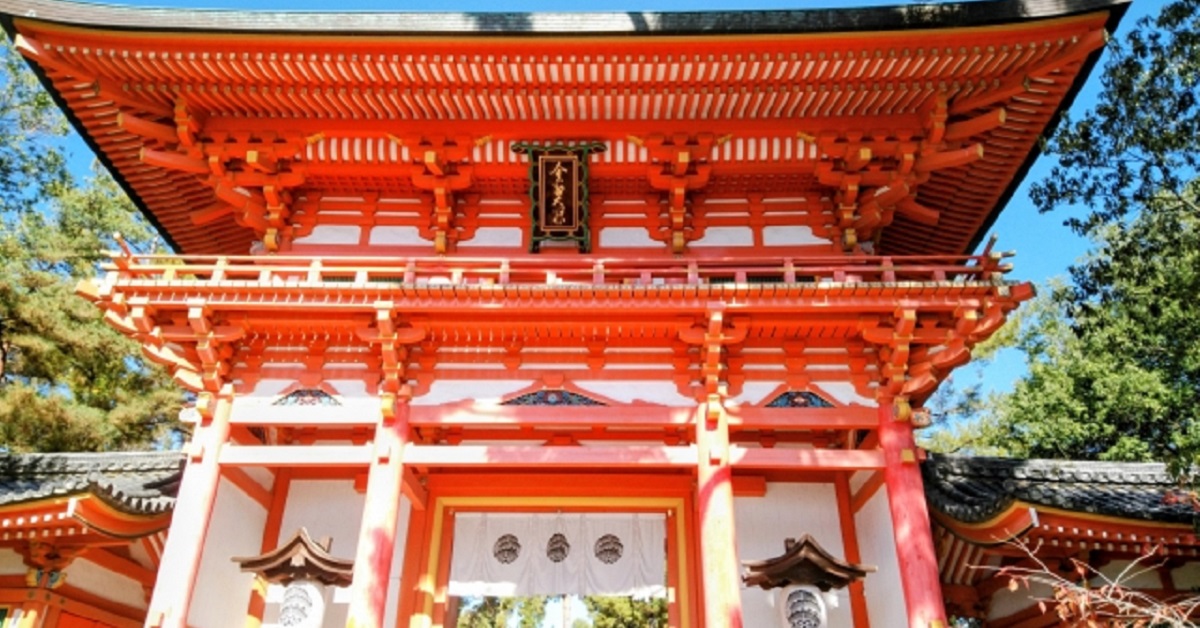The iconic “Oneri” scene in the film KOKUHO was filmed at Imamiya Shrine in Kyoto. As Kikuo and Hanjirō walk toward the moment of succession, their steps speak of artistic inheritance and silent resolve. The shrine’s solemn atmosphere merges with the film’s visual grace, capturing the instant when tradition and the human spirit intertwine.
Imamiya Shrine – A Living Symbol of Kyoto’s Tradition
Located in Kyoto’s Kita Ward, Imamiya Shrine is a historic shrine that dates back to the Heian period. It is also known as the “Tama no Koshi Shrine”, revered for granting good fortune, prosperous marriage, and longevity.
Ancient trees stand throughout the grounds, painting the landscape with cherry blossoms in spring and vibrant colors in autumn. The shrine is also home to the “Yasurai Festival”, one of Kyoto’s three great festivals, designated as an Important Intangible Folk Cultural Property of Japan. It continues to embody the city’s enduring faith and community spirit.
During the filming of KOKUHO, the sacred approach and grand gate of Imamiya Shrine served as the stage for one of the film’s most profound moments, capturing the stillness and reverence of tradition itself.
| Feature | Description | Cultural Value |
|---|---|---|
| Foundation | Around 994 AD (Heian period) | Originated as a shrine to ward off epidemics |
| Main Deities | Ōnamuchi-no-Mikoto, Kotoshironushi-no-Mikoto, Sukunahikona-no-Mikoto | Gods of healing and matchmaking |
| Specialty | Aburi-mochi (grilled rice cake) | Traditional sweet offering to the gods |
| Major Events | Yasurai Festival, Annual Grand Festival | Celebrations for good health and protection |
The tranquil landscape and dignified stillness of Imamiya Shrine perfectly harmonized with the artistic vision of the film.
Kikuo and Hanjirō – Pride and Resolve in the Rite of Succession
In KOKUHO, the “Oneri” procession symbolizes the spiritual bond between master and disciple. Kikuo, about to inherit a revered stage name, carries the heavy weight of responsibility, while Hanjirō, his mentor and senior disciple, stands by as a pillar of guidance and quiet strength.
Their walk together represents the “resolve and connection” of those who inherit traditional art. Every step, every subtle motion, and every gaze embodies years of discipline and devotion.
| Character | Role | Symbolic Meaning |
|---|---|---|
| Kikuo | Successor | Symbol of artistic inheritance and renewal |
| Hanjirō | Mentor, senior disciple | Symbol of discipline, guidance, and compassion |
| Spectators | Witnesses | Symbol of society’s reverence for tradition |
The scene values not spectacle but the quiet strength within silence, delivering a deeply emotional and spiritual experience to the audience.
Why Imamiya Shrine Was Chosen
The filmmakers did not choose Imamiya Shrine by chance. Its atmosphere of “prayer, inheritance, and solemn purity” perfectly aligned with the film’s themes.
Filmed in the early morning, soft sunlight streamed through the shrine’s gate, illuminating the stone path. The gentle echo of footsteps sounded like a vow to the gods. As the wind moved through the trees, it seemed as though nature itself was blessing the two men.
| Filming Element | Effect | Symbolic Expression |
|---|---|---|
| Morning sunlight | Soft contrast | Symbol of renewal and purification |
| Stone pathway | Echoing footsteps | Emphasizes resolve in the path of art |
| Shrine silence | Spiritual focus | Represents inner determination and prayer |
| Lush greenery | Continuity of tradition | Shows harmony between nature and culture |
The staff remarked that “the light and air of Imamiya Shrine gave life to the film.”
Imamiya Shrine as a Pilgrimage Site
After the film’s release, Imamiya Shrine became a pilgrimage site for fans of KOKUHO. The approach and grand gate, where the “Oneri” was filmed, are now visited by many who wish to experience the movie’s spiritual atmosphere firsthand.
Visitors retrace the same path that Kikuo and Hanjirō walked, feeling the weight of tradition and the echo of art within the shrine’s silence. The tranquil environment allows them to relive the emotional core of the film.
| Highlight | Description | Visitor Impressions |
|---|---|---|
| Shrine Approach | Main filming site | “You can feel the tension of each step.” |
| Grand Gate | Central location | “The sacred atmosphere is overwhelming.” |
| Aburi-mochi Shop | Shrine specialty | “The aroma adds warmth to the memory.” |
| Shrine Grounds | Seasonal beauty | “Time feels suspended in tranquility.” |
Visiting this location deepens one’s understanding not only of the film but also of Kyoto’s rich cultural heritage.
The Message of Artistic Inheritance
KOKUHO is more than a film about traditional performance; it explores the timeless question: “What does it mean to pass something on?”
The “Oneri” scene visually conveys the sacred act of inheritance — not merely of skill, but of spirit and heart.
Succession is not just inheriting a name; it is inheriting a soul.
As Kikuo walks under Hanjirō’s watchful gaze, the essence of art itself is distilled into a single act of devotion. Their contrast — the youthful determination of Kikuo and the seasoned calm of Hanjirō — reveals the profound depth of traditional artistry.
Through this portrayal, the film quietly teaches that the heart of tradition lies not in preservation, but in connection — in passing one’s spirit to the next generation.
Conclusion
The “Oneri” scene in KOKUHO stands as a masterpiece where sacred space and cultural heritage converge.
The presence of Kikuo and Hanjirō symbolizes the continuum of art from past to future, leaving a lasting impression of reverence and beauty.
To visit Imamiya Shrine is to experience both the emotion of the film and the essence of Japanese spirituality. The stillness of the shrine seems to carry the faint echo of their footsteps, reminding visitors that tradition is alive — breathing, evolving, and eternal.
Kyoto’s history, its prayers, and the beauty of artistic dedication meet in this sacred place, truly deserving the name “a living sanctuary of the Japanese soul.”






